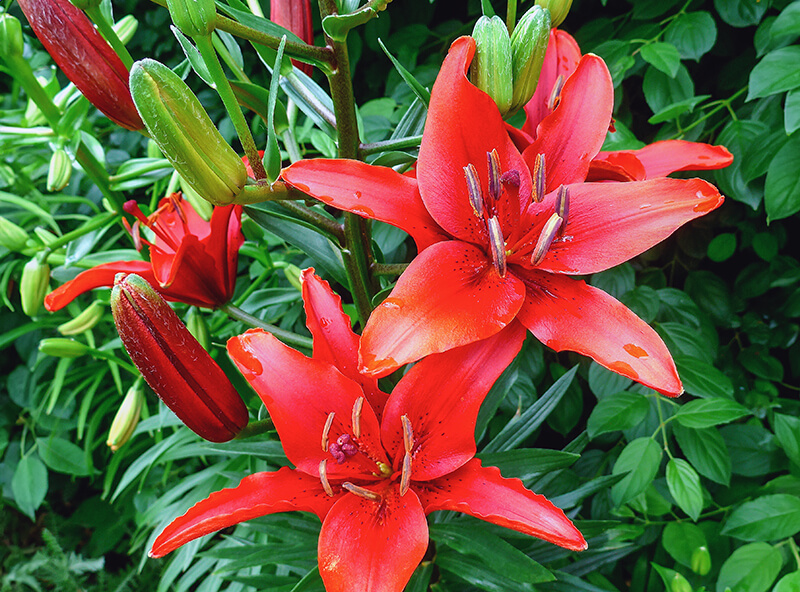Gregor Mendel and Inherited Traits
Gregor Mendel was a monk in the 1800s. His study of pea plants demonstrated how offspring inherit traits from parent plants. Sadly, no one seemed interested in Mendel’s studies until around 1900, when three other scientists discovered similar evidence of inherited traits. Since then, researchers have continued to build on what Mendel discovered. The first activity in this lesson can serve as an introduction for teaching about inherited traits; students will dissect a flower to learn how plants reproduce, passing traits on to offspring through seeds.
How Seeds Are Produced
To understand inherited traits in plants, you need to understand how seeds are produced. Seeds contain embryos that develop into plants. Before a plant can form a seed embryo, pollination and fertilization must occur in the flower. The reproductive organs of plants are found in the flower. The male parts of the flower include the filament, which looks like a stalk, and the anther at the top of the filament, which produces pollen grains. Pollination occurs when pollen from an anther is transferred to a stigma. The stigma is the female part of the flower that is specially developed to catch pollen grains. Below the stigma is the style. A pollen grain that has been caught by the stigma reaches down the style to fertilize the egg (or eggs) in the ovary. This fertilization process creates a seed (or seeds) inside the ovary. In most cases, the ovary then swells and becomes the fruit of the plant (e.g., cherries, avocados, apples, cucumbers).
Self-Pollination and Cross-Pollination
Many flowers contain both male and female parts. Some plants can pollinate themselves; they are self-fertile. Other plants have chemical or physical barriers to self-pollination and need to be cross-pollinated. In cross-pollination, pollen is delivered to a flower of a different plant. Plants adapted to cross-pollinate usually have taller stamens (collective male parts) than pistils (collective female parts) to better spread pollen to other flowers. In self-pollination, pollen moves from the anther to the stigma of the same flower or to another flower on the same individual plant. The seeds from self-pollinated flowers produce plants that look like the parent plant. This isn’t true with cross-pollination, which yields offspring of two different parents. The offspring of cross-pollinated plants may show some traits from both parents or may not resemble either parent.
Plants that cannot self-pollinate require a pollenizer—a separate plant to provide pollen. Even plants that can self-pollinate will often produce larger fruit and healthier offspring with a pollenizer. A good pollenizer is a plant of the same species that blooms at the same time as the plant to be pollinated and provides compatible, viable, and plentiful pollen. Peaches are considered self-fertile because fruit can be produced without cross-pollination, although cross-pollination usually produces a better crop. Apples are considered self-infertile; most apple trees will not form fruit without cross-pollination by an apple tree of a different variety. Pollination is critical for the production of many important agricultural crops, including corn, wheat, rice, apples, oranges, tomatoes, and squash.
The Role of Pollinators
In addition to planting the proper pollenizers for their crop, farmers must also consider whether their crops require a special pollinator. The terms pollenizer and pollinator are often confused—a pollenizer is a plant that provides pollen; a pollinator is an agent that moves pollen, whether it be wind, water, bees, bats, moths, or birds. Insects are among the most common pollinators.
Many flowers grow flashy petals and produce unique smells to attract insect pollinators to their rich supplies of pollen and/or nectar (sticky, sweet liquid on the end of the stigma). These flowers trade sweet nectar and protein-rich pollen in return for the pollination service that insects perform as they move from flower to flower. Insects don’t just pollinate flowers for fun; most are collecting food.
Different insects are attracted to different types of flowers depending on color, scent, and size. Butterflies are attracted to orange, yellow, pink, and blue flowers that have large landing pads. Moths are active at night, requiring flowers that are open and provide nectar at night. Large, white flowers are particularly easy for moths to find in the dark. Honey bees see colors on the higher end of the human visual spectrum, including ultraviolet, which humans cannot see. Honey bees tend to prefer blue, purple, and yellow flowers that have sweet scents.
It’s common to see bee boxes in orchards because honey bees are good pollinators for many fruit crops. Once a honey bee finds an abundant source of nectar and pollen, it will return to the hive and tell other bees how to locate that source by performing a dance. After a hive is placed in an orchard, it doesn’t take long for a steady stream of busy bees to start buzzing from flower to flower. Honey bees have lots of little hairs on their bodies, and a furry bee moving around inside a flower picks up a lot of pollen. Some of this pollen will be brought back to the hive for food, but some will be deposited on the stigmas of other flowers that the bee visits, pollinating those flowers. In an orchard, lots of pollinated flowers will lead to lots of tasty fruit!
